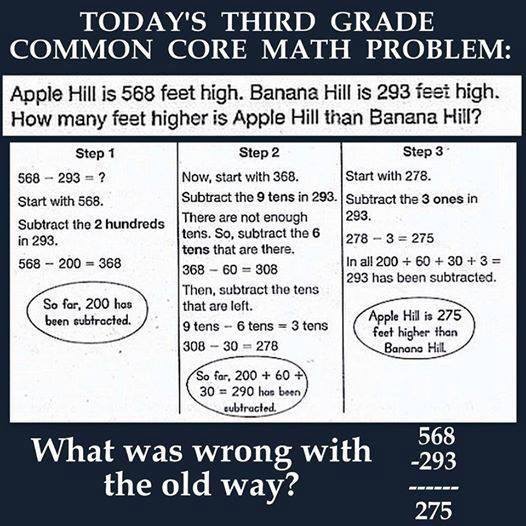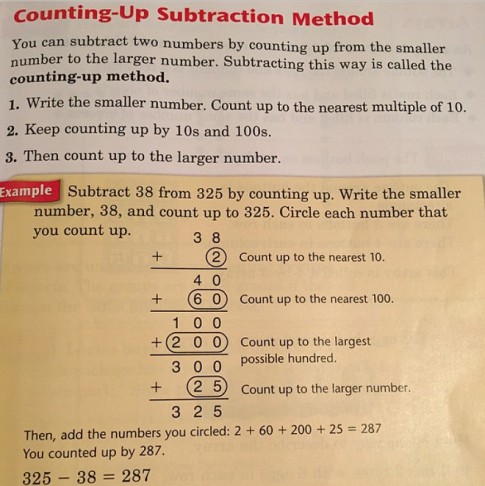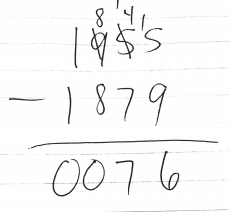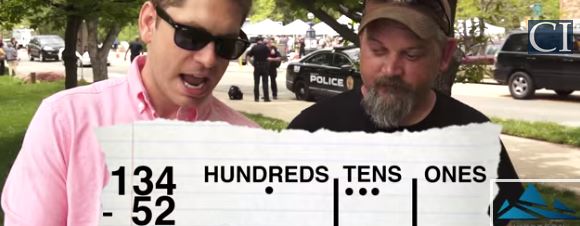Here we go again! I just saw the following on Facebook:
What was wrong with the old way? Before I answer…IT”S NOT THE OLD WAY! It’s just A WAY! If you want to read much about misunderstanding the common core, consider the other posts with a title “Misunderstanding the Common Core Parts I-IX”. I will reiterate, recap, and re-explain for anyone new to this blog.
When we subtract as shown at the bottom of the image, 568 – 293 = 275, there is a lot going on in terms of understanding the algorithm. Understanding the algorithm is what allows us to be efficient and accurate in computing by hand. Which brings us to an interesting issue: most people would use a calculator to do this!
Suppose you were going to attempt to compute 568 – 293 in your head. Or, suppose you were estimating. You might start with 568 – 200 = 368 just to get the thinking started. You might estimate/round 293 and say it is nearly 300 so 568 – 300 is about 268. Here’s my point…the most important digits are the digits in the 100’s place not the 1’s place! It is much more natural to start with the 100’s place than with the 1’s place as is traditionally done.
Let’s get back to it…once we think 568 – 200 = 368, the next thing to think about is the 10’s place. Let’s subtract 90 more. 368 – 90….hmmmmm…well…368 – 60 would be 308….hmmm…10 more…308 – 10 = 298….hmmm…20 more…298 – 20 = 278. It’s hard to do in writing but what I am trying to convey is that when people think about computations mentally, they might first focus on easier computations…subtracting 60, then 10, then 20 is much easier to do in my head that subtraction all 90 all at once.
So, we have subtracted 568 – 290 so far and have arrived at 278. Now subtract 3 more…278 – 3 = 275. There you go! 568 – 293 = 275!
It would happen much faster in my head in reality than it seems when you read through everything that is happening in my head. Here it is in one, smaller space:
568 – 293….well, 568-200 = 368….now 368 – 90 is 368 – 60 = 308 and 308 – 10 = 298 and 298-20 = 278. Finally, 278 – 3 = 275…done…and fast!
What’s wrong with the old way? Nothing! What’s wrong with thinking, focusing on place value, mental math, understanding algorithms, and number sense? Nothing!
Here is the bottom line to me when it comes to this particular image. When we try to explain our thinking and show all the details of doing a simple subtraction problem, it might look convoluted and confusing. When we really think about how things work and try to understand the structure of the algorithm, it can make perfect sense!
One more thought…at the bottom of the image, we see this…
People look and say…wow, look how easy that was compared to that new, crazy math that my kids are coming home with! Yea, right! There is so much missing that many 3rd graders would not understand!
Likely, people would start on the right and find that 8 – 3 = 5. Fine.
Next, people would look at the 10’s place…6 – 9…hmmm…you can’t take 9 from 6! Sometimes kids see this and their brains tell them to think about 9 – 6 and they put 3 in the 10’s place! But we know, you have to “borrow” from the 100’s place and actually subtract 16 – 9 = 7 (note…I am ignoring place value here since that is the traditional thing to do).
Finally, move to the 100’s place. Remember we borrowed 1 (ignoring place value and meaning) from the 5 to make it 4. So, 4 – 2 = 2 so put a 2 in the 100’s place.
There is so much going on here that a 3rd grader has to figure out. The creator of this image chooses to omit it in order to present a stark contrast from “the old way” to the “common core way.”
Making sense of mathematics (in this case 3rd grade subtraction) as I have tried to do in this blog post is not crazy…it is not new….it is just MATH!*
*Credit to Dr. Ted Coe!




 With the double borrowing, mistakes can be made. In addition, I am a fan of mental math…it can absolutely be a helpful and healthy thing to keep track of quantities mentally!
With the double borrowing, mistakes can be made. In addition, I am a fan of mental math…it can absolutely be a helpful and healthy thing to keep track of quantities mentally!

